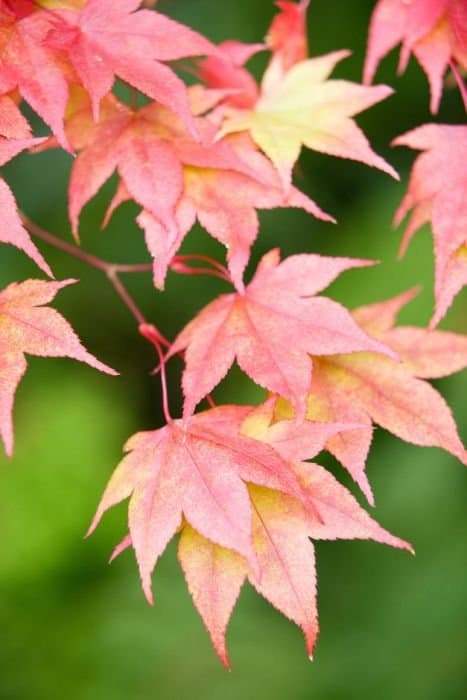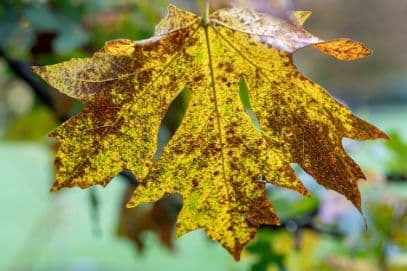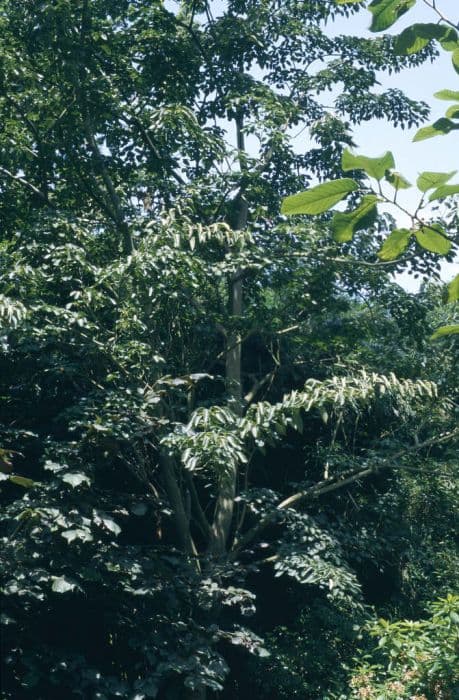Montpellier Maple Acer monspessulanum

ABOUT
The plant known as Montpellier maple has a distinctive appearance characterized by its attractive foliage and growth habit. The leaves have a unique shape, being trifoliate, meaning they are composed of three smaller leaflets. Each leaflet is broad and somewhat rounded, with a smooth edge that gives the foliage an overall elegant look. The leaflets come together at a central point, creating a shape that is somewhat reminiscent of a classic maple leaf but with a more simplified and less serrated outline. The color of the leaves is typically a deep green, which can turn into a range of warm hues, from yellow to orange and sometimes a deep reddish-purple, during the fall season. The bark of the Montpellier maple presents a smooth, grayish surface when the tree is young, but it becomes more furrowed and textured with age. This gives the tree an interesting character that can be appreciated up close or from a distance. Flowers of the Montpellier maple are often inconspicuous, with male and female flowers appearing on separate trees. When the tree flowers in the spring, the blooms are modest, often green or yellowish-green, and hang in loose clusters. Though not flashy, they add a gentle decorative touch to the tree. Following the flowering period, the plant produces winged seeds, which are known as samaras. These seeds are arranged in pairs and can whirl down from the tree like little helicopters when they fall, a trait that is common among maple trees. The samaras boast a light brown color and provide a further point of visual interest in late spring and summer as they mature. Overall, the Montpellier maple has a balanced and pleasing aesthetic, making it a popular choice for ornamental purposes in parks and gardens where its lush foliage and modest decorative features can be appreciated throughout the changing seasons.
About this plant
 Names
NamesFamily
Sapindaceae
Synonyms
Montpellier Maple, French Maple
Common names
Acer humile Salisb., Acer monspessulanum var. microphyllum (Boiss.) Briot, Acer monspessulanum subsp. microphyllum (Boiss.) Arcang., Acer cinereum Juss. ex Jacq., Acer monspessulanum var. cinereum (Juss. ex Jacq.) E. Murray, Acer elegantulum André, Acer monspessulanum var. turcomanicum Pax, Acer turcomanicum (Pax) A.E.Murray.
 Toxicity
ToxicityTo humans
Montpellier maple (Acer monspessulanum) is generally not known to be toxic to humans. There is no widespread documentation of toxicity or poisoning symptoms associated with ingesting parts of this plant for humans. However, it is always prudent to avoid ingesting parts of ornamental plants due to potential individual sensitivities or the presence of unknown compounds.
To pets
Montpellier maple (Acer monspessulanum) is not commonly known to be toxic to pets. There is limited information on the toxicity of this particular maple species to animals, and it is not typically listed among the poisonous plants to pets. Nonetheless, pet owners are advised to prevent pets from ingesting plants, as individual animals might have adverse reactions to plants that are generally considered non-toxic.
 Characteristics
CharacteristicsLife cycle
Perennials
Foliage type
Deciduous
Color of leaves
Green
Flower color
Yellow-green
Height
20-35 feet (6-11 meters)
Spread
20-30 feet (6-9 meters)
Plant type
Tree
Hardiness zones
6
Native area
Mediterranean
Benefits
 General Benefits
General Benefits- Ecosystem support: Acer monspessulanum, commonly known as Montpellier maple, supports various animal species by providing habitat and food through its seeds, flowers, and sap.
- Ornamental value: Montpellier maple is often used in landscape design for its attractive foliage, compact size, and resilience, adding aesthetic value to parks and gardens.
- Shade provision: With its spreading canopy, Montpellier maple offers shade and cooler temperatures in urban and garden environments during hot weather.
- Soil stabilization: The root system of Acer monspessulanum helps to stabilize soil and prevent erosion, particularly on slopes and in areas susceptible to land degradation.
- Seasonal interest: The Montpellier maple exhibits seasonal changes that enrich the local landscape, providing spring flowers, vibrant autumn foliage, and winter interest with its branch structure.
- Wood products: The wood of Acer monspessulanum is used for timber, woodcraft, and sometimes in the production of specialty items, contributing to local economies.
- Local biodiversity: By growing in a variety of climates and conditions, Montpellier maple enriches plant diversity, which is key for a healthy and resilient ecosystem.
- Educational value: As an indigenous species in parts of Europe, Acer monspessulanum offers opportunities for educational studies about native flora and conservation efforts.
 Medical Properties
Medical Properties- Antiseptic: The leaves of Montpellier maple may possess antiseptic properties that could prevent the growth of microorganisms.
- Anti-inflammatory: Extracts from the plant are believed to have anti-inflammatory effects which could help in reducing inflammation.
- Diuretic: Traditionally, the plant may have been used to stimulate urine production and relieve fluid retention.
- Astringent: The bark and leaves of Montpellier maple may act as astringents, which can constrict tissues and help minimize bleeding and secretions.
 Air-purifying Qualities
Air-purifying QualitiesThis plant is not specifically known for air purifying qualities.
 Other Uses
Other Uses- Acer monspessulanum wood is hard and strong, making it suitable for crafting small wooden objects, like utensils, tool handles, and toys.
- The dense wood from the Montpellier maple can be used for creating musical instruments, such as woodwinds, due to its fine grain and ability to be finely crafted.
- Fine cabinet work can employ Montpellier maple wood given its durability and ornamental grain, perfect for high-quality furniture.
- The tree's sap can be collected and reduced to a syrup, similar to how maple syrup is produced, although it is not as commonly practiced.
- Because of its moderate growth rate and compact size, the Montpellier maple is used for bonsai, offering a challenge for enthusiasts of this art.
- Its leaves and bark, rich in tannins, can be used in the traditional leather tanning process to treat hides.
- The wood of Montpellier maple, when dried, has excellent burning properties and provides high-quality firewood and charcoal.
- Montpellier maple's thick foliage provides ample shade, making it an ideal choice for urban landscaping and parks.
- The tree is also used in windbreaks and for erosion control due to its robust root system that helps stabilize the soil.
- Florists sometimes use the branches and distinctive foliage of the Montpellier maple in decorative arrangements and fall displays.
Interesting Facts
 Feng Shui
Feng ShuiThe Montpellier maple is not used in Feng Shui practice.
 Zodiac Sign Compitability
Zodiac Sign CompitabilityThe Montpellier maple is not used in astrology practice.
 Plant Symbolism
Plant Symbolism- Strength and Endurance: Acer monspessulanum, commonly known as Montpellier maple, is a hardy species that can thrive in tough conditions, symbolizing the ability to withstand challenges and remain strong.
- Adaptability: The Montpellier maple's capability to adapt to various environments represents the flexibility and resilience required to navigate life's changes.
- Beauty: With its attractive foliage and form, the Montpellier maple embodies beauty and grace, reminding us to appreciate aesthetic qualities in the natural world and in life.
- Protection: Trees are often seen as protective entities, and the Montpellier maple, with its sturdy trunk and branches, serves as a symbol of shelter and security.
 Water
WaterThe Montpellier maple requires moderate watering, and the frequency depends on the climate and soil moisture levels. Generally, during the growing season, water the plant once a week with approximately 1 to 2 gallons per session, ensuring the soil is kept evenly moist but not soggy. During the winter months, reduce watering to every two to three weeks, subject to weather conditions and soil dryness. Be mindful to avoid water logging as this species does not tolerate standing water.
 Light
LightMontpellier maple thrives in full sun to partial shade. It is best placed in a spot where it can receive at least four to six hours of direct sunlight daily, with filtered light or dappled shade during the hottest part of the day to prevent leaf scorch.
 Temperature
TemperatureThe Montpellier maple is hardy and can withstand a moderate range of temperatures. It can survive minimum temperatures down to around -10° F, and it is comfortable in maximum temperatures up to 100° F. Ideally, maintain the Montpellier maple in temperatures between 60° F and 80° F for optimal growth.
 Pruning
PruningPrune the Montpellier maple to shape the tree, remove dead or damaged limbs, and to encourage healthy growth. The best time to prune is during the late winter or early spring before new growth starts. Pruning every 2 to 3 years is generally enough to maintain its shape and health.
 Cleaning
CleaningAs needed
 Soil
SoilThe Montpellier Maple thrives in well-draining soil that's rich in organic matter. A mix of loam, peat, and sharp sand can ensure good drainage and fertility. Aim for a soil pH between 6.0 and 7.5 for optimal growth.
 Repotting
RepottingMontpellier Maples do not need to be repotted often; young trees may be repotted every 2-3 years. Mature specimens can be repotted every 3-5 years or when rootbound.
 Humidity & Misting
Humidity & MistingMontpellier Maple prefers moderate to high humidity levels. However, as a Mediterranean native, it can tolerate some dry air.
 Suitable locations
Suitable locationsIndoor
Bright, indirect light; well-draining soil; moderate watering.
Outdoor
Full sun to partial shade; shelter from strong winds; mulch in winter.
Hardiness zone
6-9 USDA
 Life cycle
Life cycleMontpellier maple (Acer monspessulanum) begins its life cycle with seed germination, which is facilitated by stratification – a period of cold to break dormancy. After germination, the seedling emerges and grows into a juvenile plant with a primary root system and initial foliage. As it matures, the Montpellier maple's root system expands, and it develops a woody stem, compound leaves, and a characteristic canopy through the sapling stage. During the mature phase, the tree starts flowering and undergoes sexual reproduction; flowers are typically small and yellow-green, leading to the production of winged fruits called samaras. Once pollinated, these samaras disperse, often by wind, allowing for the potential establishment of new individuals. The tree can live many decades, and as a mature individual, it will go through repeated cycles of flowering and fruiting annually.
 Propogation
PropogationPropogation time
Spring-Early Summer
The Montpellier maple (Acer monspessulanum) is typically propagated through seed sowing. The ideal time to sow the seeds is in the fall, shortly after they mature, which ensures that the cold stratification period naturally occurs during winter. However, this process can be mimicked artificially by storing the seeds in a refrigerator at approximately 34 to 41 degrees Fahrenheit (1 to 5 degrees Celsius) for about 60 to 90 days. The seeds are then sown in well-draining soil in pots or a nursery bed. It's important to maintain consistent moisture for germination, but avoid waterlogged conditions that could lead to rot. Seedlings usually emerge in the spring, and once they are large enough to handle, they can be transplanted to their final location.








